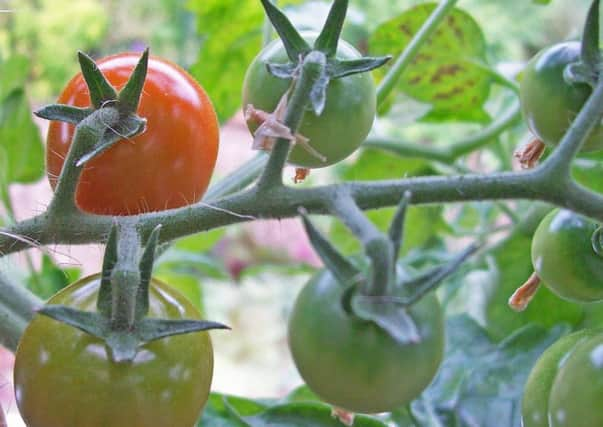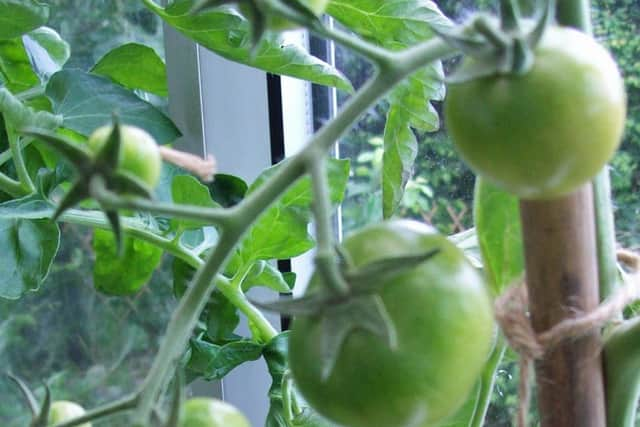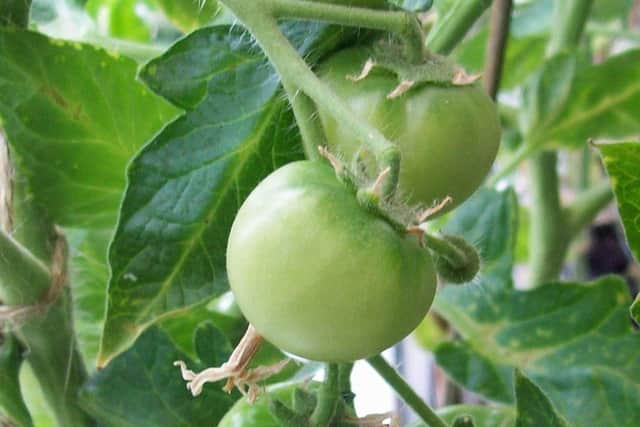Getting the best crop from your tomatoes


Even though they’re under glass, nights can still be cool, so you get big temperature fluctuations which tomatoes really don’t like.
However, the first ripe tomato has made its appearance – Suncherry Smile, a new variety this year, a shiny-skinned, red cherry.


Advertisement
Hide AdAdvertisement
Hide AdEven the one-truss tomatoes, stopped after the first one has formed (saves wasting spare plants and you’re supposed to get earlier crops) are way behind. Best of these plants seems to be Crimson Crush and Sunchocola.
The several Green Zebra plants are behind the F1 varieties and they produce a lot of leaf – they’re one of those tomatoes that don’t have what I call a ‘clean’ truss, but have leaves and stems shooting out all over the place.
Of course, the poor light has led to the plants hitting the roof already. I keep a pair of stepladders in the conservatory to reach the tops, stop them when they hit the roof and nip out side shoots (mine are all cordons).
Try and nip out side shoots once a week – I found two I missed last time and they were 3ft long!


Advertisement
Hide AdAdvertisement
Hide AdIt’s usual to hack back a lot of the green growth later on in the season, so tomatoes get more light to ripen and the plant’s energy goes into producing fruit. However, I’ve started to remove leaves that cover already-formed trusses.
Also make sure you keep up to date with your tying in of cordons and that their canes are tall enough.
Keep watering regularly – as it’s been cool here, a soaking every third day has been sufficient for the ring culture/grow bag plants, every other day for the one-truss plants.
It’s traditional to start feeding when the second truss is pea sized and mine are, but I found last year I needed only half the Tomorite I usually use, as I grew plants in Dalefoot Compost, a peat-free sheep’s wool/bracken mix, which cuts down on watering and feeding.


JOBS FOR THE WEEKEND
Advertisement
Hide AdAdvertisement
Hide AdCut back delphiniums and geraniums after the first flush of flowers to encourage a second flowering period. Feed after cutting them back.
Divide clumps of bearded iris.
Pinks and carnations that have become leggy, can be propagated by layering or by cuttings.


Sudden collapse of apparently healthy clematis, especially the large-flowered cultivars, could indicate clematis wilt.
Prune June-flowering shrubs such as Philadelphus and Weigela after flowering and deciduous magnolias if necessary.
Tie-in climbers and ramblers as they grow.
Remove rose suckers and tree suckers.
Advertisement
Hide AdAdvertisement
Hide AdThickened and curled margins on bay trees (Laurus nobilis) are a sign of damage by the bay sucker. Scale insects can also affect bays at this time of year.
Many conservatory and greenhouse pests will be active. Check plants regularly for signs of glasshouse whitefly, leafhopper, glasshouse red spider mite, mealybugs and scale insects. Yellow card sticky traps are a valuable, low-cost tool for monitoring numbers and types of flying pests in the greenhouse.
Lawn growth slows down now. Raise the cutting height slightly as the month progresses, to help the grass better resist wear.
Cover ponds with nets or safety grilles in gardens where young children play. These have the additional advantage of preventing leaves falling into the pond.
Advertisement
Hide AdAdvertisement
Hide AdClean out debris in the pond. This will improve the water quality and prevent excess debris from promoting the growth of weeds, algae or marginal plantings, and from releasing toxins that could harm fish or wildlife.